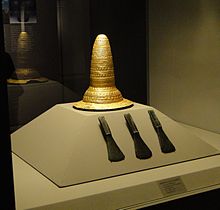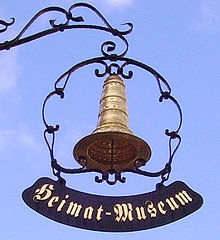Golden hat from Schifferstadt
The Golden Hat of Schifferstadt was found in 1835 during field work in a field near the town of Schifferstadt , Rhein-Pfalz-Kreis . The artefact from the Bronze Age consists of thin sheet gold and served as the outer cladding of a headgear with a brim and chin strap, which was probably made of organic material and mechanically stabilized the thin sheet of gold on the outside.
classification
The specimen from Schifferstadt is the oldest and first find out of a series of now four known conical gold sheet hats from the Bronze Age, which were made in southern Germany during the 19th and 20th centuries ( Berlin gold hat , gold sheet cone from Ezelsdorf-Buch ) and in France ( Sheet gold cones from Avanton ) were found in a more or less good state of preservation. The Schifferstadt piece has been completely preserved except for damage to the brim.
Based on three mitgefundener paragraph hatchets bronze and one ornament comparison of the time of its production to around is with other found objects 1400 bis 1300 V. Chr. Dated.
Today it is assumed that the gold hats served as religious insignia of gods or priests of a sun cult widespread in Central Europe in the late Bronze Age . This view is underpinned by the pictorial representation of an object interpreted as a cone hat on a stone slab from the grave of Kivik in Skåne , southern Sweden , in a clearly religious and cultic context.
After partial decoding of the ornament canon of the cone-shaped gold hats of the Schifferstadt type, in addition to their representative cultic function, far-reaching calendar properties are now ascribed to the sheet gold cones. It is unclear whether they were actually used as a calendar or whether they merely represent the underlying astronomical knowledge.
description
The golden hat of Schifferstadt is an ornamentally divided into horizontal bands and decorated with punch marks , about 350 grams heavy gold hat. It has a blunt, undecorated tip and a short, compact shaft with a stepped calotte and a wide brim. The gold hat is 29.6 cm high and has a diameter of about 18 cm at the base. The brim is about 4.5 cm wide.
The sheet metal of the hat was edged around the brim in the area of the brim by a copper wire - which was lost after the discovery - in order to provide additional mechanical stability.
The golden hat is divided along its entire length by horizontal decorative and frame bands and is ornamented over the entire length. Five different pattern punches and a shot punch were used to systematically decorate the horizontal bands with repetitive, similar stamp patterns.
The visual separation of the individual ornamental bands was realized by means of ring ribs or bands that were decorated with a shotgun punch. The ornamental bands mainly contain disc and circular motifs that have a circular inner hump and are framed with up to six outer rings.
A special feature is the appearance of two decorative ribbons with eye patterns, which can also be seen in a similar form on the golden hats from Ezelsdorf-Buch and Berlin . In contrast to the other gold sheet cones found, the cone tip is not crowned by a star, but completely unadorned.
An overview of the shape of the Schifferstadt gold hat as well as the type and number of the pattern hallmarks used in the respective main ornament zones is shown in the illustration opposite.
Calendar function
According to Wilfried Menghin , the gold hats of the Schifferstadt type , to which the Ezelsdorf gold cone also belongs, show a systematic sequence in the number and type of ornaments used in the individual ornamental bands. Based on investigations on the completely preserved Berlin gold hat , it turned out that an astronomical calendar based on a lunisolar system is possible on the gold hats .
For a general overview of the characteristics and functionality of the calendar functions of a Bronze Age gold hat of the Schifferstadt type, see Gold hats .
Site and history

The Golden Hat of Schifferstadt was found on April 29, 1835 during field work in the Gewann Reuschlache about one kilometer north of the village of Schifferstadt . The find was handed over to the government authorities in Speyer , which then belonged to the Kingdom of Bavaria , the very next day .
The observed and reconstructable circumstances indicate a cultic landfill : The hat was buried standing upright at a depth of about 60 cm. The tip of the hat protruded just below the surface of the earth; when it was found, the hat itself stood on a slab of lightly fired clay . The gold sheet cone itself was filled with earth or a mixture of earth and ash, which has not been preserved.
The clay plate, which has also not been preserved and which crumbled when the hat was recovered, was placed on a layer of sand about an inch thick in a "rectangular pit about 60 cm deep in the Latvians ". Three bronze heel axes , which have also been preserved, were found leaning against the hat .
Manufacturing
The artifact was produced as a forging work from a gold alloy with 86.37% Au , 13% Ag , 0.56% Cu and 0.07% Sn in one piece and has an average wall thickness of 0.20 mm in the area of the shaft and dome up to 0.25 mm. The brim is made much thinner and has an average wall thickness of only 0.08 to 0.13 mm. It is therefore assumed that the brim was reworked in ancient times.
The gold weight of the gold hat corresponds to a gold cube with an edge length of about 2.5 cm as the starting material. This gold ingot was about typing paper thickness during the machining process forged .
Due to the tribological properties of the material, the material solidifies as the degree of deformation increases and then tends to crack. To avoid these cracks, a particularly uniform deformation was required during forging . In addition, the workpiece had to be annealed repeatedly to at least 750 ° C during the manufacturing process .
Due to the low melting temperature of the gold alloy (approx. 960 ° C), a very precise temperature control and isothermal heating of the component was required in order to prevent the surface from melting . For this process, the Bronze Age craftsman used a charcoal fire or an oven, similar to the kilns for pottery , the temperature of which, however, could only be controlled to a limited extent by means of a bellows-assisted supply of oxygen .
As part of further processing, the Schifferstadt Golden Hat was provided with radial ornamental bands. For this purpose, the hollow inner body was filled with a suitable goldsmith's putty based on tree resin and wax for the purpose of stabilization , and the thin gold sheet was structured in the present form from the outside by repeatedly pressing negative marks on it .
Whereabouts
The Golden Hat of Schifferstadt is in the Palatinate History Museum in Speyer , as the centerpiece of the Bronze Age collection. A replica is available in the local history museum Schifferstadt, another is in the Pfahlbaumuseum Unteruhldingen .
Special postage stamp
The German Federal Post Office announced on August 16, 1977 under the title "Archaeological heritage" three special stamps out. The golden hat of Schifferstadt was shown on the 30-pfennig stamp.
See also
- Gold hat - general description of the gold hats of the Schifferstadt type
- Berlin Gold Hat , around 1000 to 800 BC Chr.
- Sheet gold cone from Ezelsdorf-Buch , around 1000 to 900 BC Chr.
- Avanton gold cone
- Nebra Sky Disc , around 2100 to 1700 BC Chr.
literature
- Wilfried Menghin , Peter Schauer: The sheet gold cone from Ezelsdorf. Cult devices of the late Bronze Age (= the prehistoric and early historical antiquities in the Germanic National Museum. H. 3). Theiß, Stuttgart 1983, ISBN 3-8062-0390-3 .
- Peter Schauer : The gold sheet cones of the Bronze Age. A contribution to the cultural connection between Orient and Central Europe (= Roman-Germanic Central Museum. Monographs. Vol. 8). Habelt, Bonn 1986, ISBN 3-7749-2238-1 .
- Bernhard Kukatzki : "Similar to the Tyrolean hats." The discovery of the "Golden Hat" in 1835. In: Bernhard Kukatzki, Matthias Spindler (Red.): Schifferstadt. History and stories. City of Schifferstadt, Schifferstadt 1998, ISBN 3-00-002473-5 , pp. 141–149.
- Wilfried Menghin: The Berlin gold hat and the golden calendars of the old European bronze age. In: Acta Praehistorica et Archaeologica. Vol. 32, 2000, ISSN 0341-1184 , pp. 31-108.
- Mark Schmidt: Of hats, cones and calendars or the dazzling light of the Orient. In: Ethnographic-Archaeological Journal. Vol. 43, 2002, ISSN 0012-7477 , pp. 499-541.
- Wilfried Menghin: Manifestations of Bronze Age Calendar Works. In: Gold and Cult of the Bronze Age . Exhibition catalog Germanisches Nationalmuseum Nürnberg 2003, pp. 220–235.
- Anja Grebe (Red.): Gold and the cult of the Bronze Age. Verlag des Germanisches Nationalmuseums, Nuremberg 2003, ISBN 3-926982-95-0 (exhibition catalog, Nuremberg, Germanisches Nationalmuseum, May 22 - September 7, 2003).
- Lothar Sperber among others: The Golden Hat from Schifferstadt. Historisches Museum der Pfalz, Speyer 2008, ISBN 978-3-930239-20-7 .
- Matthias Risch, Christine Zerbe: Does the Schifferstadt Bronze Age gold hat give insight into star observations 3000 years ago? In: Pfälzer Heimat 63 (2012), 2, pp. 59–69. ISSN 0031-6679 .
- Oskar Schmidt, Henriette Schmidt: What do the symbols on the Schifferstadt gold hat mean? Part 1–2. In: Schifferstadter Tagblatt vol. 110, No. 213 of September 13, 2014; No. 230 of October 4, 2014 (Lokal-Magazin). ZDB ID 1019722-9 .
Web links
- Dieter Schmudlach: Archaeological Lexicon: Golden hats and robes. Landscape Museum Obermain , Kulmbach, October 24, 2010 .
- Cult of a hat - the golden hat. In: schifferstadt.de.
- Kurt E. Kocher: The golden hat of Schifferstadt. In: hekoverlag.de. February 28, 2018 .
- The golden hat of Schifferstadt. Association for Home Care Schifferstadt, December 15, 2016(German, English, French).
- Peter Prestel , Gisela Graichen , Harald Lesch : Terra X: Unsolved cases of archeology (1/2). (Video, 43:26 minutes, "The Golden Hat" and "Nebra Sky Disc", minutes 9:37 - 13:56) In: zdf.de. March 25, 2018 .
Coordinates: 49 ° 24 ′ 0 ″ N , 8 ° 21 ′ 59 ″ E
Individual evidence
- ↑ The Golden Hat of Schifferstadt. Association for Home Care Schifferstadt, December 15, 2016, accessed on April 29, 2020 .



